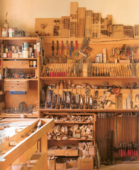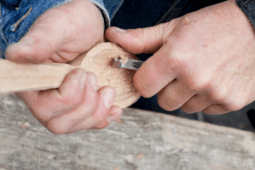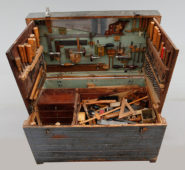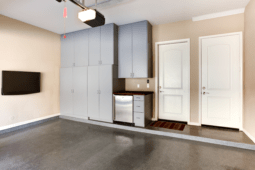ManMade Essential Toolbox: Why Every Man Should Own a Random Orbit Sander
Each week in 2015, ManMade is sharing our picks for the essential tools we think every creative guy and DIYer needs. We’ve selected useful, long-lasting tools to help you accomplish a variety of projects, solve problems, and live a hands on lifestyle that allows you to interact with and make the things you use every day.

It’s always a big step when you move from the manual version of a technique to the powered option. The miter box becomes a compound miter saw, you reach for a pneumatic finish nailer instead of a hammer, the #2 Phillips screwdriver a Li-Ion impact driver.
And while there’s still a great deal of pleasure from using hand tools, certain hand saws, bench planes, and hand drills, sanding by hand doesn’t even come close. It’s monotonous, tedious, and time consuming. It’s the least creative aspect of any project or repair … the “paperwork” of DIYing. Thus, the powered sander. There are lots of options: belt sander, oscillating spindle sanders, sanding drums, detail sanders, and the like. But if you’re looking to snag your first powered sanding machine, you want a random orbit sander.

Like the best tools, it does exactly what it says it does: it spins sanding discs, attached with a hook-and-loop fastener, in a random orbit pattern. That is, in an intentionally wobbly and inconsistent circular pattern designed to not leave repeated marks in the grain of the wood.
And? They work! They work great … for a particular kind of tasks. Namely, smoothing or removing an existing finish wide flat surfaces that are bigger than the sanding pad: box sides, cases, long planks, tabletops, cutting boards, etc. What shouldn’t they be used for? Sanding thin edges that can be rounded over, removal of material on inconsistent joint lines (you’ll create a divot), or shaping wood or curves (the pad will compress, creating facets.)
But, that one thing they do so well accomplishes a good 75-80% of smoothing or abrasive tasks, making for an incredibly versatile tool that touches nearly every project that comes out of my shop.

The sanding disks themselves have small holes that align with holes in the base, allowing the sawdust to be removed from the surface. These things aren’t inexpensive, but they’re certainly not pricey either. The trick here is: buy in bulk. This is true for all sandpaper, but especially true for these guys. Don’t go get a pack of 5, or a multi-grit combo pack of 3-4 in each grit. Get the 100 packs, every time. They’re a bit more expensive at the outset, but you’ll save money at the per-disk cost by a lot. If you don’t need 100 at a time, perhaps you could split a bulk pack with a friend. At that quantity, you’re looking at about 30 -60¢ per disk, rather than $.75-1.00.
For grits, an 80 – 120 – 80 – 220 set is nice, and will accomplish all but the most aggressive of removal tasks (you’ll look for 40-60 grit then).

When purchasing, look for a sturdy 5″ model that fits well in your hand, and is comfortable for your hand size and shape. Plug it in, and see if you can feel any noticeable vibration on the handle. If so, skip it; it’ll make you go numb after a few minutes of sanding. Multiple speeds are nice and recommended, but not essential. But a quality dust port is a must; attaching a vacuum allows for faster work and wood removal, as well as a serious decrease in airborne dust, which is good for your lungs. So, for both health and efficiency: quality, effective dust port.

If you’re buying a new one, we check out one of the following options, all in the 5″ size, and 3 amp power range. You should expect to spend around $50 – $80 for this tool, with the variable-speeds coming in at the higher end of the range. Avoid anything under $40; at this point, tools in that range just aren’t built for real work.
ManMade recommended:
- PORTER-CABLE 382 5-Inch Random Orbit Sander
- Bosch ROS20VSK 120-Volt Variable Speed Random Orbit Sander
- DEWALT D26453K 3 Amp 5-Inch Variable Speed Random Orbit Sander Kit
- Milwaukee 6021-21 Random Orbit Palm Sander
And for sandpaper, these are the ones I prefer. I don’t know if they’re the absolute best, but they sure work great for me, and cost about 40¢ a piece.








